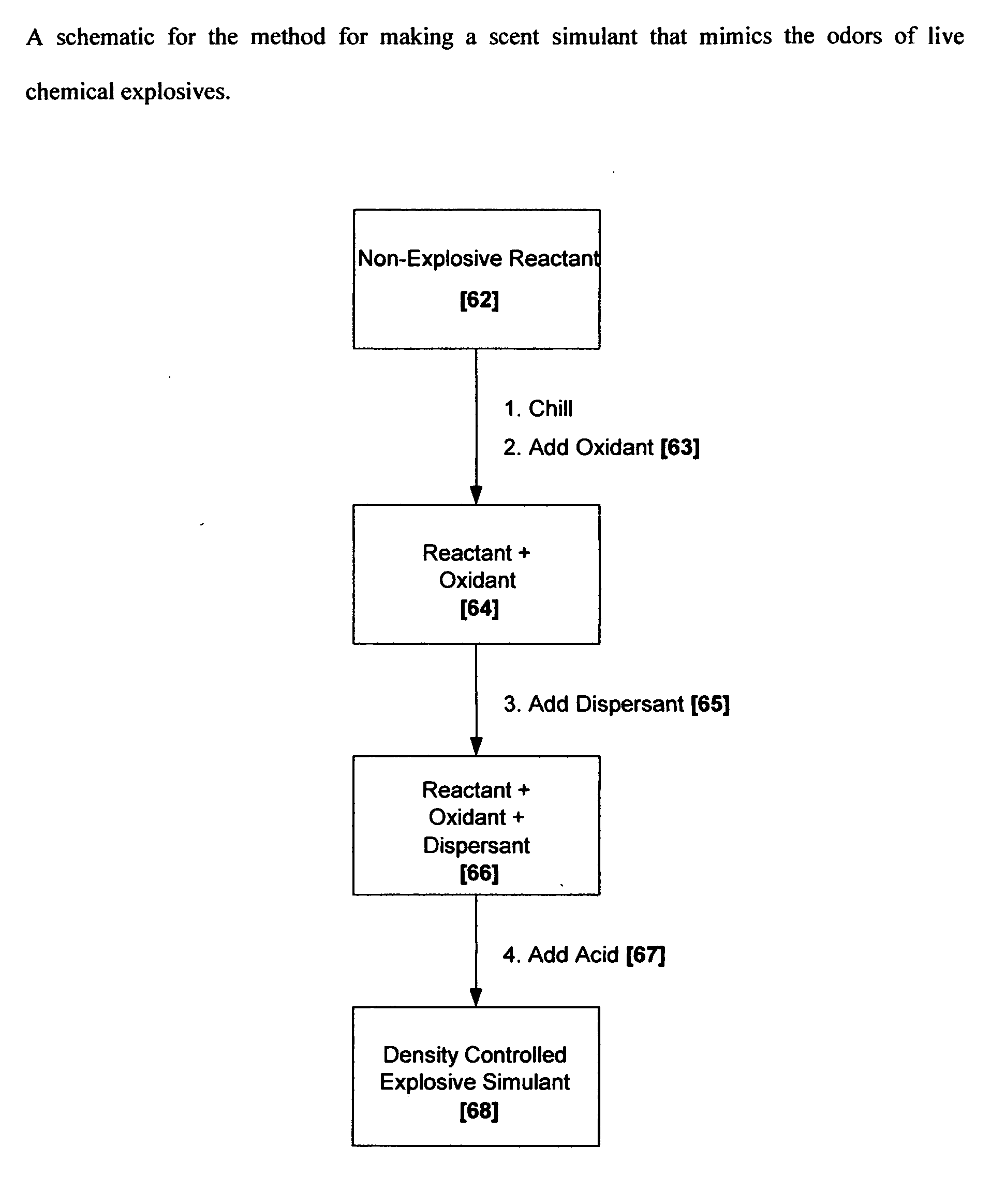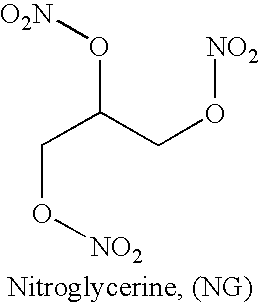Methods for making scent simulants of chemical explosives, and compositions thereof
a technology of chemical explosives and simulants, applied in the direction of explosives, other chemical processes, instruments, etc., can solve the problems of pure explosives being hazardous or impossible, and achieve the effect of increasing the degree of explosive heterogeneity
- Summary
- Abstract
- Description
- Claims
- Application Information
AI Technical Summary
Benefits of technology
Problems solved by technology
Method used
Image
Examples
example 1
Preparation of a TATP Scent Simulant
[0179]A TATP explosive scent simulant was prepared by the following chemical reaction and physical control of mechanochemical properties of the product. An amount of 11.2 g of chilled acetone (0.2 mol) was mixed with chilled hydrogen peroxide (30% in water, 60 mL, 0.5 mol), and the mixture was cooled to 0° C. temperature. In the next step, 12 g of diatomaceous earth was added to the mixture and stirring was commenced, whilst cooling. Concentrated sulfuric acid (12 drops) was added to the stirred slurry. The whole mixture was stirred for an additional 6 hours using a magnetic stirrer and then kept in a refrigerator for 16 hours without stirring. The resultant precipitate was collected by filtration with suction. It is then rinsed with cold water and air-dried to afford a dry weight of 16 g of white material. This represents 4 g of TATP intercalated within the diatomaceous earth.
[0180]To assess the specificity of the material as a TATP scent simulan...
example 2
Preparation of a HMTD Scent Simulant
[0184]A HMTD explosive scent simulant was prepared by the following chemical reaction and physical control of the mechanochemical properties of the product. Hexamine (7 g) was added to a stirring solution of 1 25 ml 30% H2O2 that was cooled to 0° C. in a salt ice-bath. Diatomaceous earth (14 g) was added to the mixture and stirring with continued cooling. After a period of ten minutes, 10 g of citric acid was added in portions, while stirring, maintaining a temperature of 2° C. for 3 hours. The solution was then stirred for 24 hours with the cooling removed. The resultant precipitate was collected by filtration with suction. It was then rinsed with 200 ml cold water (twice), 100 ml 5% sodium bicarbonate solution (twice), and again with 200 ml cold water (twice) and then with methanol. It was then rinsed with cold water and air-dried to afford a dry weight of 20 g of white material. This translates to a yield of 58% of intercalated HMTD. The whole ...
example 3
Preparation of a TNT Scent Simulant
[0189]A TNT explosive scent simulant was prepared by the following chemical reaction and physical control of the mechanochemical properties of the product. Diatomaceous earth (20 g) was added to a stirring solution of 60 ml of 95% HNO3 that was cooled to 0° C. in a salt ice-bath. Cooling temperature was maintained and toluene (3 g) was added in portions, while stirring and maintaining a temperature of between 5° C. and 10° C. Stirring continued for 3 additional hours. The temperature was raised to 80° C. for a period of three hours and then stirred for 6 hours with the cooling removed.
[0190]The whole was again heated to 90° C. and then a combined solution of 6 ml concentrated sulfuric acid and 8 ml of nitric acid was added to the mixture with stirring. Temperature was maintained for an additional 70 minutes after which it was removed from the water bath and left standing for an additional 6 hours. The resultant precipitate was collected by filtrati...
PUM
| Property | Measurement | Unit |
|---|---|---|
| porosity | aaaaa | aaaaa |
| temperatures | aaaaa | aaaaa |
| molecular weight | aaaaa | aaaaa |
Abstract
Description
Claims
Application Information
 Login to View More
Login to View More - R&D
- Intellectual Property
- Life Sciences
- Materials
- Tech Scout
- Unparalleled Data Quality
- Higher Quality Content
- 60% Fewer Hallucinations
Browse by: Latest US Patents, China's latest patents, Technical Efficacy Thesaurus, Application Domain, Technology Topic, Popular Technical Reports.
© 2025 PatSnap. All rights reserved.Legal|Privacy policy|Modern Slavery Act Transparency Statement|Sitemap|About US| Contact US: help@patsnap.com



